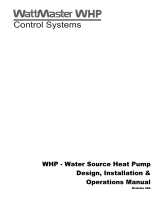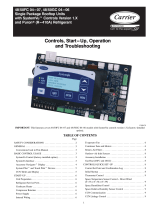Page is loading ...

Manual 2100-559
Page 1 of 6
CONTROLLER INSTALLATION
OPERATION & QUICK START
Controller: 8403-066
ECU Series Controller
Manual: 2100-559
Supersedes: NEW
File: Tab 19
Date: 05-02-11

Manual 2100-559
Page 2 of 6
TABLE OF CONTENTS
Installation
Note ........................................................................... Page 3
Controller Installation ................................................. Page 3
Controller Connections .............................................. Page 3
Start-Up
Note ........................................................................... Page 4
Basic Operation ......................................................... Page 4
Quick-Start Programming........................................... Page 4
Model Selection & System Enabling ............ Pages 4 & 5
Temperature Setpoints & Notes ................... Pages 5 & 6

Manual 2100-559
Page 3 of 6
*INSTALL NOTE: For optimum temperature sensor
performance, the Bard ECU-Series Controller must be
mounted on an interior wall and away from any heat
sources, sunlight, windows, air vents, air circulation
obstructions, and/or any other cause of erratic or false
temperature sensing.
Controller Installation: Mounting controller
1. Complete rough-in wiring using a minimum 18
AWG control wiring, see Controller Connections:
Control Wiring for exact number of conductors.
2. Turn the hex screws in the bottom and top of
Controller clockwise (inward) until they clear the cover. Remove Base Plate from controller.
3. Route completed wiring through Base Plate.
4. With the embossed “UP” arrows of the Base Plate pointing to the ceiling, fasten the Base Plate to
the desired wall location or vertical 2x4 wall handybox.
5. Make appropriate control wire connections (see Controller Connections: Control Wiring) to
the terminal blocks.
6. Replace Controller over Base Plate, being careful not to pinch/dislodge connections.
7. Turn hex screws in bottom/top of Controller counter-clockwise (outward) to secure cover.
Controller Connections: Control Wiring
Attach control wiring per control wiring diagram/terminal legend below.
C
5
3
1
6
4
R
7
BLOCK
F
E
Y1
G
W1
W2
Y
UNIT LOW
VOLTAGE
TERMINAL
2
IN3
IN4
-A
+B
24V
24 COM
IN2
GND
OUT 9
GND 7-9
OUT 8
OUT 7
RLY 6
SC 4-6
RLY 5
RLY 4
RLY 3
SC 1-3
RLY 2
RLY 1
MIS-2852 C
8403-066 DIGITAL
CONTROLLER
lanimreTnoitcnuFepyTmroF
B+)desuton(+PTSMsnoitacinummoC
A-)desuton(-PTSMsnoitacinummoC
4NIrosneSerutarepmeTroodtuOtupnI3epyTMHOK01
3NIrecudsnarTerusserPtupnIGISP007-0,CDV5-0
DNGsdnuorGrosneStupnI
2NImralAtuokcoLtupnIerusolCyaleR
MOC42moCCAV42rewoP
V42CAV42rewoP
9TUOlortnoCrotoMnaFtuptuOgolanACDV01-0
9-7DNGdnuorGlortnoCtuptuOgolanA
8TUOlortnoCdioneloSredaolnUtuptuOgolanAMWPCDV5ro0
7TUOlortnoCrotoMrewolBtuptuOgolanACDV01-0
4YLR1#rotcatnoCretaeHtuptuOyaleRyaleR
6-4CS6-4stuptuOyaleRotCAV42rewoP
5YLR2#rotcatnoCretaeHtuptuOyaleRyaleR
6YLR)desuton(
3YLR)desuton(
3-1CS3-1stuptuOyaleRotCAV42rewoP
2YLRrotcatnoCrosserpmoCtuptuOyaleRyaleR
1YLR)desuton(

Manual 2100-559
Page 4 of 6
START-UP NOTE: Upon initial power-up, indoor fan will cycle on for approx. 30 seconds, and then shut off.
System will be in the “OFF” position. Default time and date will be 12:00 a.m., Jan. 1, 2000.
- In order for the system to operate in either heating or cooling mode(s), the controller must be
initially programmed with specific HVAC model number, specific System Enabling, and
appropriate temperature Setpoints.
Basic Operation: Home, Main Menu, and Override Screens
Navigate the menus and change settings by pressing a combination of
various arrow buttons and the Enter button. Push the:
• Enter button to select and/or exit value editing
• Up or Down button to move among entries
• Right or Left button to move among value fields
• Left button to return to the home screen
Quick-Start Programming: Model Selection, System Enabling, and Temperature Setpoints
Model Selection – to select specific HVAC unit model from the Home Screen, press:
1. Right button to access the Main Menu Screen
2. Down button through entries to highlight Advanced
3. Enter button to select Advanced and enter Advanced Screen
4. Enter button again to select/enter Applications Screen
5. Controller will ask for Admin Level Password
Factory Default Admin Level Password: BARD
6. Down button to highlight Additional Setup
7. Enter button to select/enter Additional Setup Screen
8. Enter button again to select/enter Unit Model Screen
9. Enter button again to highlight current model
10. Up/Down buttons to choose from available models:
- W3*V Model – Wall Mount 3-Ton Variable Capacity System (Factory Default)
- W5/6*V Models – Wall Mount 4/5-Ton Variable Capacity Systems
- P60/72*V Models – Packaged 5/6-Ton Variable Capacity Systems
11. Enter button to select/save appropriate model
12. Left button (5x) to navigate back to Home Page
System Enabling – to access system types from the Home Screen, press:
1. Right button to access the Main Menu Screen
2. Down button through entries to highlight System
3. Enter button to select System and enter System Screen
4. Enter button again to select System Enable
5. Up/Down buttons to choose between six (6) options.

Manual 2100-559
Page 5 of 6
System Enabling (Cont’d.)
Auto: Conventional System in “Auto-Changeover” mode.
HVAC system will cycle heating and cooling automatically
to stay within preset heating and cooling Setpoints.
Heating: Conventional System in “Heating-Only” mode.
HVAC system will cycle heating in reference to Heating
Setpoint only. Unit will not activate cooling sequence.
Cooling: Conventional System in “Cooling-Only” mode.
Setpoint only. Unit will not activate heating sequence.
HVAC system will cycle cooling in reference to Cooling
Off: HVAC system is inactive.
CCVC: “Continuous Compressor, Variable Capacity” application in auto-changeover mode.
HVAC system will cycle heating and cooling automatically to stay within preset heating and
cooling setpoints. Compressor will modulate from 100% to 20%, but will not shut off. Typically
used for applications where cycling of compressor is not allowable due to use of on-site generators
– an MRI Mobile Trailer, for instance.
CCFC: “Continuous Compressor, Full Capacity” Application in auto-changeover mode. HVAC
system will cycle heating and cooling automatically to stay within preset heating and cooling
setpoints. Compressor will not modulate, but will stay at 100% capacity and will not shut off.
Typically, this mode is selected for testing purposes only.
*NOTE: Upon initial start-up of any system-enable utilizing compressor, the unit may undergo a series of
self-diagnostics, wherein a series of audible “clicks” are heard. This may delay compressor function for
up to 5-minutes.
6. Enter button to select chosen operational mode
7. Left button to navigate back to Main Menu Screen
8. Left button to navigate back to Home Page
Temperature Setpoints – to access Setpoints from Home Screen, press:
1. Right button to access Main Menu Screen
2. Down button through entries to highlight Setpoints
3. Enter button to select Setpoints and enter Setpoints Screen
- Use the Up/Down buttons to scroll through setpoints
Cool Setpt / Heat Setpt are for occupied periods
Cool Setback / Heat Setback are for unoccupied periods, and will only be used if scheduling
is enabled (see the Advanced Programming section)
Min Setpt Diff is the closest the Heating and Cooling setpoints can come to one another. (3°F
is recommended minimum)
Deadband is the space in degrees from setpoint in which the Cooling and/or Heating sequence
will modulate to 100% capacity (2°F is recommended minimum).
4. Enter button to select specific Setpoint option
5. Up/Down button to enter specific degree amount for setpoint
6. Enter button to save new setpoint.
7. Left button to navigate back to Main Menu Screen
8. Left button to navigate back to Home Page
*NOTE: Although the cooling/heating setpoints can be accessed by simply pressing the arrow keys
during normal operation, any changes made in this fashion will be for a specific length-of-time as an
“override” feature only. This temperature change will not be permanent. See the Advanced
Programming section for further information.

Manual 2100-559
Page 6 of 6
**NOTE: Any system start-up conducted with indoor ambient temperatures lower than 56°F or above
86°F will experience an internal Low-Temperature or High-Temperature alarm. This will not affect
normal operation, and can be cleared easily. See the Advanced Programming section for further
information. Start-up procedures conducted with extreme temperatures indoors/outdoors may cause a
“SERVICE” warning flashing on the face of the controller. This also will not affect normal operation, and
should clear itself once interior temperatures and refrigerant pressures normalize.
***NOTE: ECU-Series Controller will become sluggish/inoperable at extremely low temperatures
(< 20°F). Care should be taken to warm controller before initial start-up.
ECU-Series Controller should be fully operational at this point. For further controller enhancement or
operation detail, please consult the Advanced Programming section.
/

